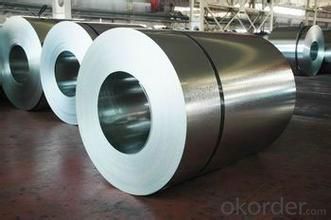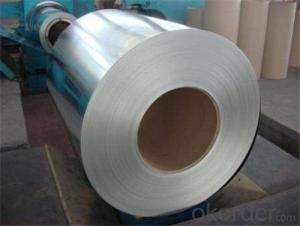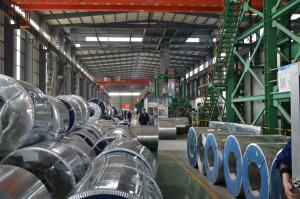Gavanized steel coils
- Loading Port:
- China Main Port
- Payment Terms:
- TT OR LC
- Min Order Qty:
- -
- Supply Capability:
- -
OKorder Service Pledge
Quality Product, Order Online Tracking, Timely Delivery
OKorder Financial Service
Credit Rating, Credit Services, Credit Purchasing
You Might Also Like
Packaging & Delivery
| Packaging Detail: | hot dip galvanized steel coil, GI, PPGI STANDARD EXPORT PACKING |
| Delivery Detail: | WITHIN 25 DAYS AFTER DOWNPAYMENT |
Specifications
hot dip galvanized steel coil, GI, PPGI Various pattern with competitve price
- Q: Why does steel with several composites have a greater hardenability from quenching than low carbon steel alloys?Any help would be great
- Bit tricky to explain and I don't know muh about it but steel on its own has lost of gaps in it ( the molecular structure) and when carbon is added thos gaps are filled, I think of it like this: it is easier to punch through expanded polystyrene( with all the little balls) than unexpanded(just a lump of plastic) as the balls are not properly joined and have air pockets between them.
- Q: I'm looking to buy the Milano Stiletto, and it uses 1045 steel. I was just wondering whether this will hold up and keep an edge.
- C1045 Steel
- Q: What are the environmental benefits of using steel coils?
- There are several environmental benefits associated with using steel coils. Firstly, steel is a highly recyclable material. Steel coils can be easily recycled and repurposed into new steel products, reducing the need for mining and extraction of raw materials. Recycling steel also requires less energy compared to producing it from scratch, resulting in lower greenhouse gas emissions and a smaller carbon footprint. Additionally, steel is known for its durability and longevity. When used in construction or manufacturing applications, steel coils can last for decades without losing their structural integrity. This reduces the need for frequent replacements, which in turn reduces the consumption of resources and energy required for production. Furthermore, steel is highly resistant to corrosion and weathering, making it a suitable choice for outdoor applications. This resistance to decay means that steel coils can withstand harsh environmental conditions and maintain their functionality for extended periods. This reduces waste generation and the associated environmental impacts of replacing damaged or deteriorated materials. Lastly, steel is a versatile material that can be used in a wide range of industries and applications. Its versatility allows for efficient use of resources, as steel coils can be easily adapted and customized to meet specific project requirements. This versatility also enables the use of steel in sustainable building designs, such as energy-efficient structures or green buildings that incorporate renewable energy systems. In conclusion, the environmental benefits of using steel coils include their recyclability, durability, resistance to corrosion, and versatility. By choosing steel coils for various applications, we can contribute to resource conservation, reduced carbon emissions, and a more sustainable future.
- Q: What are the factors to consider when selecting steel coils for a specific application?
- There are numerous factors to consider when choosing steel coils for a particular application. These factors encompass the type of application, the necessary strength and durability, the desired aesthetic appearance, the allocated budget, and any specific industry standards or regulations that must be met. Firstly, it is crucial to identify the type of application for which the steel coils will be utilized. Various applications may necessitate different steel types with varying properties. For instance, if the coils are intended for use in structural construction, high-strength steel with exceptional structural integrity may be necessary. Conversely, if the coils will be employed in automotive manufacturing, steel with good formability and weldability may be more appropriate. The required strength and durability represent another crucial factor to contemplate. This includes factors such as load-bearing capacity, resistance to corrosion, and the ability to withstand extreme temperatures or environmental conditions. The selected steel coils must be capable of enduring the specific stresses and strains inherent in the intended application. The desired aesthetic appearance is also significant, particularly in applications where the steel coils will be visible. Considerations may include the surface finish, color, and texture of the steel coils. This consideration is especially pertinent in industries such as architecture or interior design, where the visual appeal of the steel plays a pivotal role. Budgetary constraints should also be taken into account when selecting steel coils. The price of different steel grades and types can vary significantly. Striking a balance between desired properties and available budget is important. In some cases, compromising on certain factors may be necessary in order to adhere to financial limitations. Lastly, any specific industry standards or regulations must be considered during the selection process. Certain industries, such as aerospace or automotive, may impose strict requirements on the materials used in their products. It is essential to ensure that the chosen steel coils meet all necessary standards and regulations in such cases. In conclusion, when choosing steel coils for a specific application, careful consideration should be given to factors such as the type of application, required strength and durability, desired aesthetic appearance, budget, and industry standards or regulations. By taking these factors into account, an informed decision can be made to select the most suitable steel coils for the intended application.
- Q: What are the different methods of coil welding for steel coils?
- There are several different methods of coil welding for steel coils, including resistance welding, laser welding, and induction welding. Resistance welding involves applying pressure and passing an electrical current through the coils to create a weld. Laser welding utilizes a high-powered laser beam to melt and fuse the edges of the coils together. Induction welding involves using electromagnetic fields to heat and fuse the coils. Each method has its own advantages and is chosen based on the specific requirements of the application.
- Q: What are the typical coil thickness options?
- The typical coil thickness options vary depending on the specific application and industry. However, common coil thickness options range from 0.005 inches (0.13 mm) to 0.250 inches (6.35 mm).
- Q: How are steel coils used in the manufacturing of storage cabinets?
- Steel coils are used in the manufacturing of storage cabinets as they are processed and shaped into sheets or panels, which are then cut, formed, and assembled to create the structural framework and outer shell of the cabinets. The steel coils provide strength, durability, and rigidity to the cabinets, ensuring their ability to withstand heavy loads and provide long-lasting storage solutions.
- Q: How are steel coils used in the manufacturing of roofing materials?
- Steel coils are used in the manufacturing of roofing materials by being processed and shaped into various forms such as sheets, shingles, or panels. These coils are typically coated with protective layers to enhance durability and resistance to corrosion. The coils are then cut, formed, and assembled to create the final roofing product, ensuring strength, reliability, and longevity for the roofs.
- Q: I believe steel is stronger but it steel lighter than iron too?
- Steel is iron, with other things added that strengthen it and/or make it less rust liable. So, in general, steel is stronger than iron. In so far as the density, that depends on the steel alloy. Some are higher than iron, some lower. Remember there are hundreds of different steel alloys. edit: but the density is still close to that of iron. density steel 7750 to 8050 kg/m? density iron 7870 kg/m?
- Q: What are the common coil surface treatments available for steel coils?
- Steel coils can be treated with various methods to improve their durability, resistance to corrosion, and appearance. These treatments serve different purposes and offer different benefits. 1. Galvanized Coating: A layer of zinc is applied to the surface of the steel coil, providing excellent protection against corrosion. This coating is commonly used in outdoor applications or high humidity environments to prevent rust and increase the coil's lifespan. 2. Phosphating: A chemical treatment that creates a thin layer of phosphate coating on the steel coil's surface. This treatment improves the adhesion of subsequent coatings and enhances the coil's paintability. It also offers some corrosion resistance and can be used as a pre-treatment before painting or powder coating. 3. Chromate Conversion Coating: Also known as chem film or Alodine, this treatment involves applying a thin layer of chromate to the steel coil's surface. It provides corrosion protection and acts as a primer for other coatings, improving their adhesion. It is commonly used in aerospace and electrical applications. 4. Powder Coating: In this dry finishing process, a fine powder is electrostatically applied to the steel coil's surface and then cured under heat. The result is a durable and attractive finish that offers excellent resistance to chipping, scratching, and fading. Powder coating is available in a wide range of colors and textures, making it a versatile option. 5. Organic Coatings: Liquid paints such as acrylic, polyester, or polyurethane are applied to the steel coil's surface. These coatings provide aesthetic appeal, protection against corrosion, and resistance to weathering and UV radiation. They are commonly used in architectural and automotive applications. 6. Anodizing: Primarily used for aluminum coils, anodizing can also be applied to steel coils. This treatment involves creating an oxide layer on the coil's surface through an electrochemical process. It enhances corrosion resistance and provides an attractive finish. Anodizing is commonly used in architectural and decorative applications. It's important to consider specific requirements, including performance, aesthetics, and environmental factors, when choosing a coil surface treatment. Consulting with a professional in the steel industry can help determine the most suitable treatment for a particular project.
Send your message to us
Gavanized steel coils
- Loading Port:
- China Main Port
- Payment Terms:
- TT OR LC
- Min Order Qty:
- -
- Supply Capability:
- -
OKorder Service Pledge
Quality Product, Order Online Tracking, Timely Delivery
OKorder Financial Service
Credit Rating, Credit Services, Credit Purchasing
Similar products
Hot products
Hot Searches
Related keywords




























